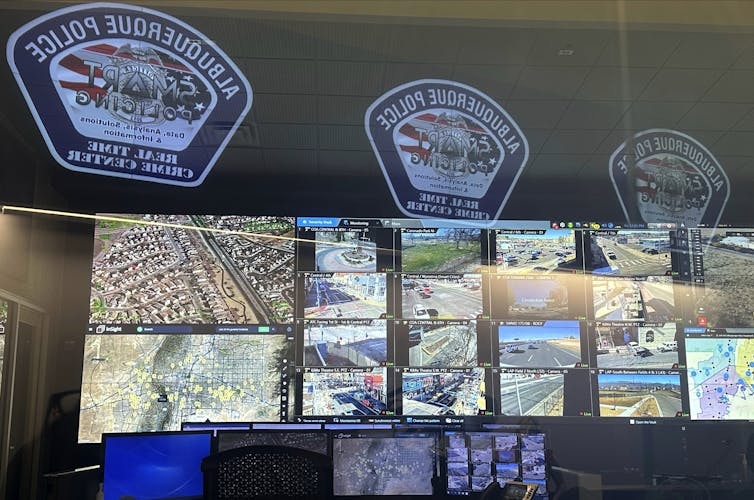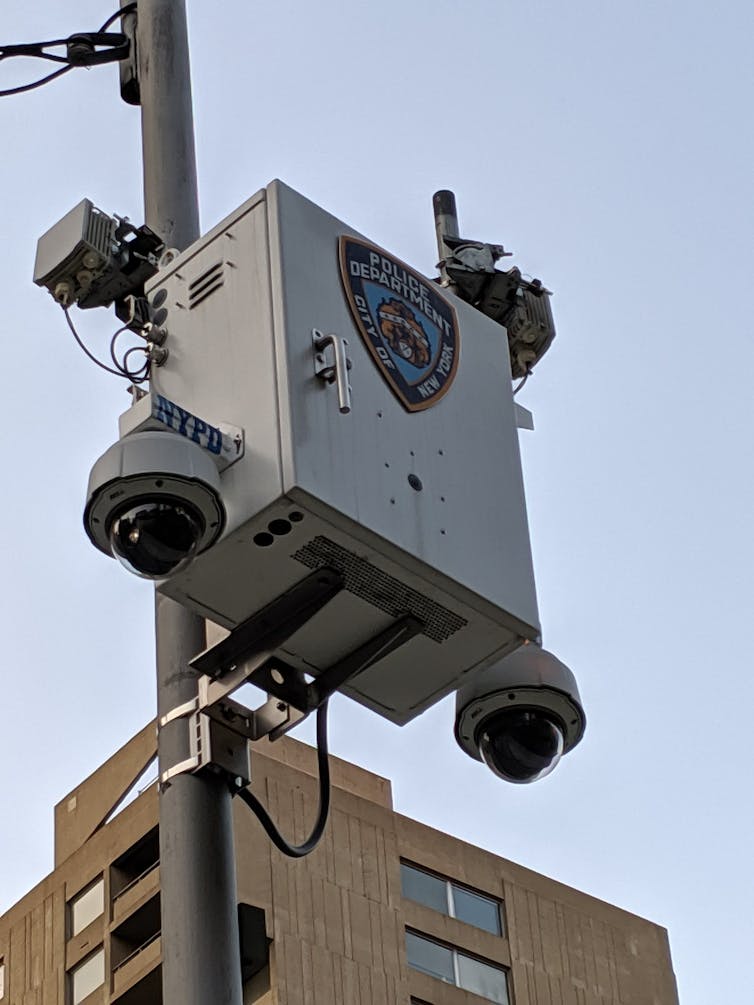
In 2021, a driver in Albuquerque, New Mexico, ran a red light, striking and killing a 7-year-old and injuring his father. The suspect fled the scene and eventually escaped to Mexico. Using camera footage and cellphone data, the Albuquerque Police Department’s real-time crime centre played a crucial role in identifying, apprehending and charging the person at fault. The driver was ultimately sentenced to 27 years in prison, providing a measure of justice to the grieving family.
Real-time crime centres are specialised units within police departments that use the latest technology to monitor public spaces and record incidents. The New York City Police Department was the first to institute a real-time crime centre in 2005.
Real-time crime centres often focus on video surveillance, using closed-circuit television systems, license plate scanners, body cameras worn by officers and drone cameras. The centres sometimes also include gunshot detection and computer-aided dispatch systems, live or static facial recognition, cellphone tracking and geolocation data, and access to probation, parole and arrestee information. Police departments are adding the latest innovations, such as video analytics driven by deep learning artificial intelligence, to identify objects and assess subjects’ behaviour.
Some real-time crime centre operations and surveillance methods are controversial, especially those using technologies that are rapidly evolving, such as drones and automated image analysis.
As a professor of criminal justice and criminologist formerly embedded within the Miami Police Department, I can explain how these centres function – and the safeguards they employ to assure accountability and appropriate use.
Instant assistance
Real-time crime centres typically function around the clock and fulfil several critical roles. They provide real-time video feeds and other essential data to officers responding to incidents. Police departments also use them to monitor ongoing situations such as protests or threats to critical infrastructure.
Detroit’s police officials credit the city’s real-time crime centre with helping them solve violent crimes.
In some real-time crime centres, like those used by the Chula Vista Police Department, near San Diego, and Metro Atlanta, drones act as an initial first responder and can stream live footage from the field back to the centre.
Real-time crime centres also can support investigations after an incident has occurred. The monitoring technologies can track the movement of a suspect’s vehicle, assist in documenting video evidence for prosecution or even pinpoint where gun casings may be found at a crime scene. Many incidents showcase how this process leads to faster resolutions of criminal investigations, often allowing investigators to locate suspects in hours instead of days.
Agencies of various sizes increasingly collaborate with business communities and large institutions to share live CCTV video footage. This collaboration allows agencies to access video feeds from locations like hotels or arenas without needing to install their own expensive equipment, which can cost tens of thousands of dollars per unit.
Expanding, but effective?
Real-time crime centres are rapidly expanding across the US, growing by 148% over the past four years. Around 150 police agencies have adopted these units. Despite this growth, real-time crime centres are still considered relatively new in policing, used by less than 1% of all agencies nationwide. Even among larger police agencies, characterised by the amount of full-time personnel and corresponding budgets, only 12% have done so.
Despite the increasing presence of real-time crime centres, only a few major studies have investigated their impact. A 2019 evaluation of decentralised real-time crime centres within the Chicago Police Department showed a 3% to 7% decrease in both violent and property crimes after the centres had been installed. A study of real-time crime centre effectiveness using data from the same source revealed a 5% increase in solving violent crimes, a 12% increase in solving property crimes and an 11% overall improvement in case clearance rates.
A more recent Miami Police Department real-time crime centre evaluation found a 66% higher likelihood of clearing cases of violent crime incidents compared with cases not supported by the centre. Clearance rate is a measure of how many reported crimes the police successfully handle. A crime is considered cleared when the police arrest and charge those involved, or if it’s resolved in other ways, such as if the suspect dies or if the victim decides not to cooperate.
Nonetheless, real-time crime centres have shown limited effectiveness in addressing some types of violent crime such as sexual assault and domestic violence, likely due to the typically private nature of these offences. Further research is needed to fully understand how effective real-time crime centres can be across all types of crimes.
Police departments typically place surveillance cameras in public spaces like major intersections. CyprianLatewood/Wikimedia Commons, CC BY-SA
Safeguards against abuse
Accountability in policing is essential. The rapid advancement of technology raises particular concerns about privacy, surveillance and secure storage of sensitive information.
These issues underscore the need for strong safeguards, which are rapidly evolving and are sometimes overlooked by the police or those in charge of the systems they acquire. Recently, police departments have made changes to address these concerns to alleviate systemic issues or biases in investigations, including changing policies for the use of technologies like facial recognition. Human verification remains crucial for validating information and outcomes in each case.
Departments keep detailed records whenever any search or monitoring occurs, both to improve transparency and to justify additional support or funding. People can request these records through a Freedom of Information Act or request information from their local agencies records unit, though fees may apply. Commonly documented materials include video footage and license plate reader data.
Records related to less severe offenses are generally retained for no more than 30 to 90 days, while evidence pertinent to homicide investigations may be preserved indefinitely. Ongoing investigation data is typically withheld until the case is resolved.
Of the over 1,100 agencies that use drones, most offer the public access to a live drone flight map to improve transparency, and most are cautious that negative community feedback could result in a programme eventually being cut.
Becoming commonplace
Real-time crime centres are rapidly expanding nationwide and likely to become commonplace in policing soon. The technologies they use are powerful, particular when combined in real time, but some of the concerns they raise are valid.![]()
Kimberly Przeszlowski, Assistant Professor of Criminal Justice, Quinnipiac University
This article is republished from The Conversation under a Creative Commons license. Read the original article.
10 Comments
This is probably the single best application for AI. With enough cameras and facial and other recognition tools you have your very own Minority Report.
Doesn’t mention Precogs so maybe not……
Reads as responsive not preventative - I’m all good with this……
Obviously the ultimate goal is a preventative. Crims will be tagged and basically watched 24/7 the system never sleeps. Full time tracking, a bunch of boy racers or kids trying to steal cars will be tracked leaving home before they even get to cause trouble. I'm all good with this, are people not sick of the level of crime in this country already and kids that need a good kick in the arse because obviously the parents are not in control.
"Ultimately, arguing that you don't care about the right to privacy because you have nothing to hide is no different than saying you don't care about free speech because you have nothing to say."
Edward Snowden
There aren’t many technologies that possess the dual characteristics of benign benefit and totalitarian control. Rolling out mass surveillance without iron clad civil rights protections sets a slippery slope for government overreach. We’ve all had enough of that in the last few years.
I’ve more had enough of crime levels in the last few years…….
Case in point: https://www.rnz.co.nz/news/national/525474/boy-racers-ram-police-cars-d…
You mean, you've had enough of reading stories about crime in the past few years.
Most crime has actually been trending way down over the past decade or two.
Can you point me to the stats for that statement - you might well be right.
Despite different means of measuring crime, the statistics show that the reported crime rates in New Zealand were low for the first half of the 20th century - but rose steeply from 1950, peaking in 1992, and has steadily declined since then
The crime rate has continued to decline in the twenty-first century. In 2010, the number of murders fell by about 25% from the previous year. Reported crimes have generally become 6.7 percent less frequent.[22] In 2011, New Zealand's recorded crime rate was at its lowest in 15 years, down another 5.6% on the figures from 2010.[32] In 2012 (financial year), the crime rate dropped another 5.9 per cent on the previous year – taking into account an increase in the population of 0.7%. Homicide and related offending dropped by 21.5%
This is just Wikipedia (Dangerous I know), but if you want lots of charts and stats the Police's website has a lot more detail.
The irony about Surveillance is that the 'West' envies China's surveillance state systems.


We welcome your comments below. If you are not already registered, please register to comment
Remember we welcome robust, respectful and insightful debate. We don't welcome abusive or defamatory comments and will de-register those repeatedly making such comments. Our current comment policy is here.